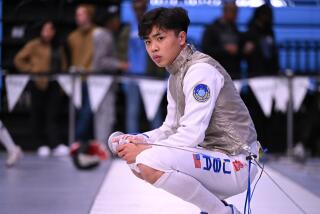Pena Takes a Stab at Gaining National Respect
- Share via
In the minds of many people, fencing ranks right up there with lawn bowling and dressage. Boring probably is too kind a word.
On the other hand, real fencing--the kill-or-be-killed kind Errol Flynn and Tyrone Power demonstrated in movies such as “Captain Blood” and “The Black Swan”--was something that could not only draw an audience but keep it awake.
Ironically, a number of the modern-day fencers competing at the Southern California fencing tournament this weekend at Harvard School in Studio City say they were drawn into the sport after seeing the old-time swashbuckling movies. It wasn’t long before they discovered competitive fencing is a lot tougher than Errol and Tyrone made it look.
“In this country, when people think of fencing they think of Zorro,” said Linda Beyer, who helped organize the two-day tournament that has drawn some of the best fencers in the United States. “A lot of competitors here probably at one time saw a Three Musketeers movie, got excited about it and took a fencing class somewhere.”
In the case of Brian Pena of Sherman Oaks, that’s not far from the truth. Pena, 30, is one of the best fencers on the West Coast. He first became involved in the sport while attending the Renaissance Faire in Agoura where fencing was being demonstrated. Pena, then 22, had sort of looked at himself as a Renaissance kind of guy, so he loaded on some protective gear and proceeded to be embarrassed by another participant.
“I enjoyed Renaissance art, classical music, the movies, ballet,” he said. “I figured fencing went along with those things--it fit the image. But once you get into competing, an interest in classical music won’t help you. I was bad.”
As a senior at UCLA, Pena took a fencing class and then tried out for the fencing team. He made it as an alternate, he said, “because the team wasn’t that good.”
After college, he joined Salle Couturier, a fencing club in Culver City, and began training three times a week. To strengthen his legs and further his Renaissance image, Pena took a ballet class at Valley College during the day and continued his fencing lessons at night.
Within three years, he went from an unclassified ranking, the lowest of the U.S. Fencing Assn.’s six levels, to an A ranking, the highest. Of the 7,000 fencers registered with the USFA, only about 100 are at the A level.
In 1984, Pena was among the country’s 30 best fencers. Last year, he finished fourth in the Pacific Regionals before going on to the national tournament in New York. He lost his first three bouts and was eliminated.
Now Pena is trying to come back. And, the way he sees it, the tournament at Harvard is his chance to make a splash nationally by beating some of the highest-ranked fencers in the country.
After Saturday’s first round, he had won all four of his bouts and was seeded No. 12 out of 106 competitors.
“Brian has good concentration, good reflexes and he’s experienced,” said Jerry Steiner, a member of the USFA and one of the tournament’s directors. “It becomes a game of physical chess and he’s a good thinker. He’s a classic-type fencer. He doesn’t do a lot of jumping and banging. He plays with the blade, he plays chess.”
At 6-2, Pena is taller than most fencers. He seemingly floats across the playing surface--a 14-meter-long, 2-meter-wide “strip.” As his left hand curls in the air in almost mystic fashion, he holds the foil handle between his thumb and index finger of the other hand and flicks at his opponents, teasing them until they get careless and flustered. Then he wipes them out.
Just the way Captain Blood did.
Except, of course, without the blood.
“I hope to make it to the top 20,” Pena said. “I’m excited about this tournament. I think I’m doing really well.”
But even if he wins the event and eventually makes it to the top 20, how much notoriety will he gain outside the fencing community?
“Zero,” he said.
Or maybe he meant “Zorro.”
More to Read
Get our high school sports newsletter
Prep Rally is devoted to the SoCal high school sports experience, bringing you scores, stories and a behind-the-scenes look at what makes prep sports so popular.
You may occasionally receive promotional content from the Los Angeles Times.






